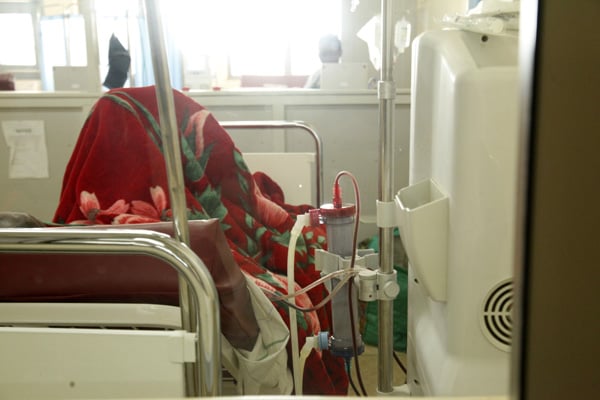Palliative care in Uganda: The journey so far

Home. Children under palliative care during a learning activity at Kawempe Homecare Centre in Kampala in September. Photo by Beatrice Nakibuuka
What you need to know:
- Tracking progress. Twenty-six years ago, patients with life-threatening diseases would be killed faster by the pain than the ailment. It is no longer the case as pain killers, especially oral morphine, have been introduced to improve the quality of life of the patient, one of the components of palliative care.
At the age of 38, Ms Esther Nyachwo was diagnosed with cervical cancer in 2011 and started receiving treatment from the Uganda Cancer Institute (UCI).
Ms Nyachwo had a swelling on her private parts, which later developed into a wound. Despite chemotherapy and radiotherapy treatment, she still had to endure pain, bleeding and a stench emanating from the wound.
“I could hardly sleep because of the pain, and I was so worried and stressed because of the cost of treatment and stench from my private parts that kept everyone away from me, including my husband,” she narrates.
Around the same time, her elder sister and caretaker, Ms Esther Akango, developed a swelling on her right breast and was diagnosed with breast cancer.
She had to undergo surgery. Her wound also started smelling before her breast was finally cut off.
As both women suffered physical and psychological pain, their family members were equally depressed and needed comfort too.
“Yes, we had had treatment, but we needed more than just that. A special kind of patient care, which I found at Hospice [Africa - Uganda ]. The same care that was given to my sister,” Ms Nyachwo says.
Ms Akango says: “I was devastated after losing my breast. Without this palliative care, I probably would be in my grave by now.”
Such is the agony that both patients with incurable and end-stage diseases such as cancer and HIV/Aids suffer from. However, they need more than the treatment, but palliative care. Unlike 26 years ago when patients with life-threatening diseases would be killed faster by the pain than the disease, it is no longer the case as pain killers, especially oral morphine, have been introduced to improve the quality of life of the patient. This is just one component of a palliative care package.
According to the World Health Organisation (WHO), palliative care is an approach that improves the quality of life of patients and their families facing problems associated with a life-threatening illness, through prevention and relief of suffering.
This is done through early identification and impeccable assessment and treatment of pain and other problems in the physical, psychosocial and spiritual aspects.
Palliative care is also a component of Universal Health Coverage (UHC), which is key to achieving the Sustainable Development Goals (SDGs) by 2030.
In Uganda, the need for palliative care started in the early 1990s when HIV/Aids was at its peak as there was no known treatment.
The situation created the need for palliative care to manage the symptoms and physical and psychological pain.
Beginnings
It is upon this background that Prof Anne Merriman, the founder of Hospice Africa-Uganda (HAU), an NGO which offers palliative care, introduced this kind of treatment.
HAU has cared for more than 30,000 patients through its three centres in Kampala, Mbarara and Hoima districts and currently has more than 1,500 in its care.
Prof Merriman, who is also the director of policy and international programmes at HAU, says palliative care is rewarding.
“Working with the critically ill and the dying is a special calling and it is usually a joy. We see our patients relieved of their pain and symptoms within their own homes, where they want to be, which brings joy to the patient, as well as the family,” she says.
With the introduction of antiretroviral drugs (ARVs), HIV/Aids ceased to be a life-threatening disease since the drugs helped manage the symptoms.
However, with the rise in non-communicable diseases such as diabetes, hypertension and kidney diseases resulting from poor lifestyles, the demand for palliative care doubled.
For example, statistics from UCI indicate that 80 per cent of the cancers are presented late when the disease can no longer be cured. The only option is palliative care.
Dr Henry Ddungu, an oncologist at UCI, says in 1998, when he had just started practicing palliative care, many patients with cancer and HIV/Aids would be discharged and left to die in pain.
“And then when you intervene, the pain goes away along with the smell, vomiting and diarrhoea. These are some of the things that made me feel good in treating patients in a lot of distress,” Dr Ddungu says.
He says during home visits in the 1990s, people used to experience a lot of pain, including physical and emotional.
“You would find a home in a lot of emotional pain because of the suffering their loved one is experiencing such as nursing a smelly septic wound,” he says.
Although it was initially spearheaded by NGOs, government has also boosted palliative care.
For instance, palliative care has been integrated into Uganda’s Health Sector Strategic Plans since 2004 and included in the National Minimum Health Care Package (NMHCP).
Government has also funded Hospice Uganda to manufacture morphine, which they supply to the National Medical Stores (NMS).
The NMS distributes it to public institutions authorised to prescribe it and patients who cannot afford it receive the drug free of charge while Joint Medical Stores distributes the drug to authorised private institutions.
Although it was initially accessed in referral hospitals in the early 1990s, one can now access it at district general hospitals and health centre IVs.
Morphine, a highly regulated drug, is the world’s strongest painkiller that controls moderate to severe pain.
Depending on the weight and condition of the patient, both adult and child patients in severe pain can take the drug at intervals of four hours as prescribed by health workers.
The late Dr James Makumbi, then Minister of Health, allowed and supported the first imports of oral morphine in 1993.
In 2004, Uganda was the first country to allow nurses and clinicians to prescribe morphine, a narcotic pain reliever usually given to cancer patients to supplement the limited number of doctors.
The law allowing midwives to prescribe pethidine for women in labour was expanded to allow nurses specially trained in palliative care to prescribe morphine.
Currently, there are more than 13 non-governmental palliative care hospitals in the country which offer home care.
Home centres
These include Raise of Hospice Jinja, Hospice Tororo, Hospice Mbarara, Hospice Hoima, Kawempe Homecare, New Life Hospice Arua, Peace Home Care in Adjumani District, Hospice Ngora, St Francis Home Care, Palliative Care Unit -Mulago and Joy Hospital in Mbale, among others.
However, the progress in the provision of palliative care has had some challenges. Mr Mark Mwesigwa, the executive director of the Palliative Care Association of Uganda (PCAU), says although at least 97 districts in the country have got access to palliative care, more needs to be done to create awareness.
“Direct funding is not adequate, the medicine is available but the primary healthcare to make people aware of palliative care is lacking,” Mr Mwesigwa says.

Treatment. A patient undergoes dialysis at a hospital in Uganda. Kidney-related diseases also need palliative care. PHOTO/FILE/RACHEL MABALA
He also adds that the nature of the recruitment structure is also a challenge where nurses that have been trained in palliative care are not recognised in public service in the structure.
“You find that when they go back to hospitals, they are deployed in theatres,” he adds, calling for the national policy on palliative care.
Prof Merriman also says: “We used to look after 2,000 patients before the closing of the funding, but we can now look after 1,500 among the three sites (mobile hospice Mbarara, Hoima and Kampala).”
In 2015, the Quality of Death Index published by the Economist Intelligence Unit ranked Uganda as the second in Africa after South Africa and 35th globally out of the 80 countries studied.
According to the WHO 2018 Country Profiles, non-communicable diseases were estimated to account for 33 per cent of all deaths in Uganda in 2016.
The Ministry of Health also revealed that in 2018, there were 32,617 new cancer cases and 21,829 cancer deaths in Uganda, which conditions require palliative care.
But only 11 per cent of those who need pain control and palliative care access it in Uganda.
The country’s Health Sector Development Plan 2015/16-2019/20, shows that palliative care services are being offered in only 4.8 per cent of the public hospitals in the country.
Benefits of palliative care
-Provides relief from pain and other distressing symptoms;
-Affirms life and regards dying as a normal process;
-Intends neither to hasten nor postpone death
-Integrates the psychological and spiritual aspects of patient care;
- Offers a support system to help patients live as actively as possible until death;
- Offers a support system to help the family cope during the patient’s illness and in their own bereavement;
- Uses a team approach to address the needs of patients and their families, including bereavement, counselling, if indicated;
-Enhances quality of life, and may also positively influence the course of illness.
Training families
In many cases, patients are treated in hospitals for illnesses. This can be distressing for patients as these hospitals are unfamiliar to them.
In an interview last year, Dr Emmanuel Luyirika of African Palliative Care Association, said palliative care does home visits because it is where patients often feel most comfortable.
However, he added that it was important to build an infrastructure in the places where patients spend the most time.
In a survey conducted by HAU, more than 60 per cent of terminally ill patients in Uganda said they prefer to receive care in their homes.
“The best place for someone to receive palliative care is within the context of their home, with family providing much of the other support,” Dr Luyirika said.
Family integration within palliative care is an important way to improve the quality of life of a patient.
HAU has a programme in which patients’ families are educated about their loved one’s illness in order to relay care to them when palliative care professionals are not around. Palliative care provides coping strategies to not only the patient, but also the family.
HAU offers training
In 2017, nurses from different Francophone African countries underwent a three-week course in palliative course at HAU. The participants were from different countries, including Togo, Chad, DR Congo and Burundi.
The initiative not only aimed at imparting skills to participants, but also inspired them to advocate for palliative care in their counties.
“African countries are faced with many problems like lack of medication for palliative care and few trained personnel to offer the service, yet there are millions of people suffering from different chronic diseases,”Dr Eddie Mwebesa, the chief executive officer of HAU, said then.




